.
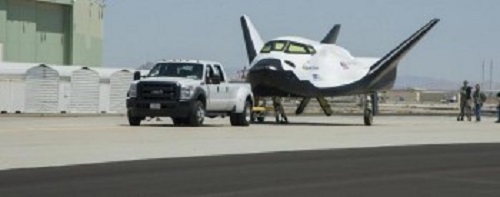
Sierra Nevada Corporation (SNC) have completed the opening salvo of tow tests on their Dream Chaser Engineering Test Article (ETA) at NASA’s Dryden Flight Research Center (DFRC). These opening test objective are being used to validate the performance of the spacecraft’s nose skid, brakes, tires and other systems.
SNC shipped the ETA to Dryden on the back of a truck, allowing Dream Chaser to join an illustrious list of vehicles that spent their early years testing their capabilities at the famous Californian facility.
Marking Dream Chaser’s arrival, NASA Administrator Charlie Bolden met with the SNC team and the ETA, noting the historical association with NASA lifting bodies and more famously Enterprise, following her series of Approach and Landing Tests (ALTs) in the 1970s, paving the way for her orbital sisters to learn how to land during the 30 year career of the Shuttle.
Dream Chaser – also known unofficially as “Eagle” – will also end her mission by landing on a runway, although there will be some key differences, especially during the actual touchdown.
The Dream Chaser is the only reusable lifting body vehicle in the running to transport American astronauts to Low Earth Orbit (LEO) destinations, such as the International Space Station (ISS). All the other commercial crew competitors are of the capsule design.
Thanks to its lifting body shape, the Dream Chaser will sport around one thousand miles of theoretical cross range.
With this capability, the vehicle can land on a runway from virtually any point in the orbit, and can land on a CONUS runway in no longer than six hours.
As such, SNC class the vehicle as capable of something they believe the ISS program considers particularly valuable, which is its “dissimilar redundancy” when compared to capsules.
With a similar, yet smaller, appearance to the Space Shuttle orbiters, Dream Chaser will closely follow in the footsteps of its big sisters during landing.
SNC have already stated that the Dream Chaser’s home landing strip will be the 15,000 ft long Shuttle Landing Facility (SLF) at the Kennedy Space Center (KSC), a runway physically marked by numerous orbiter landings over the history of the Space Shuttle Program (SSP).
The marriage between the SLF and a potential Commercial Crew provider holds extra synergy, following Space Florida’s opening talks with NASA to operate the famous runway.
For approach, Dream Chaser will be targeting a landing speed of 191 knots, after re-entering the atmosphere protected by a Thermal Protection System (TPS) that is similar to that on the Space Shuttle.
She will touch down on its two Main Landing Gear (MLG) just like the shuttle orbiters.
Click here for recent SNC Dream Chaser articles: http://www.nasaspaceflight.com/?s=SNC
However, there will be one major difference when the nose is pitched forward, given the Dream Chaser will not be using a traditional Nose Landing Gear (NLG) wheel for its rollout. Instead, and inbuilt skid strip will touch the concrete floor of the SLF.
SNC have previously noted to NASASpaceFlight.com that this system is a simple, light, safe option.
The company also added that there had been some issues with the analysis relating to the performance of tires in the space environment and this eliminates one of the tires – with the other two tires easier to control than the nose wheel if there’s a problem with one of them.
Although Concept Of Operations videos (L2 DCSS Section) show Dream Chaser was originally designed to utilize a front wheel, the Colorado company also noted they do not expect any issues, such as crosswind limitations, from using the skid during landing and rollout.
With Dream Chaser now into its test program at Dryden, engineers conducted the opening two tow tests to validate the performance of the spacecraft’s nose skid, brakes, tires and other systems.
The company has performed the tests at 10 and 20 mph – as a pickup truck pulled the Dream Chaser flight vehicle on Dryden’s concrete runways. The next tests will involve a tow at speeds of 40 and 60 mph tests later this month.
Range and taxi tow tests are standard for winged vehicles that touch down on a runway to prove the overall spacecraft handling post-landing.
Depending on how the testing proceeds, the first drop test is still expected to take place sometime later in the summer. However, serious doubts over Dream Chaser’s schedule remain, given SNC continue to avoid questions relating to testing schedules, since suffering from initial processing delays early this year.
The drop test will be conducted via the use of a helicopter, carried out early in the morning, in near darkness, before the Californian weather becomes too warm to fly the helicopter at the altitudes required for the testing.
The focus will then switch to the Dream Chaser Flight Test Vehicle (FTV), which is currently under construction.
(Images via SNC, L2 and NASA)
(With the shuttle fleet retired, NSF and L2 are providing full transition level coverage, available no where else on the internet, from Orion and SLS to ISS and Commercial Cargo/Crew, to European and Russian vehicles.
Quelle: NASA
.
Update: 15.00
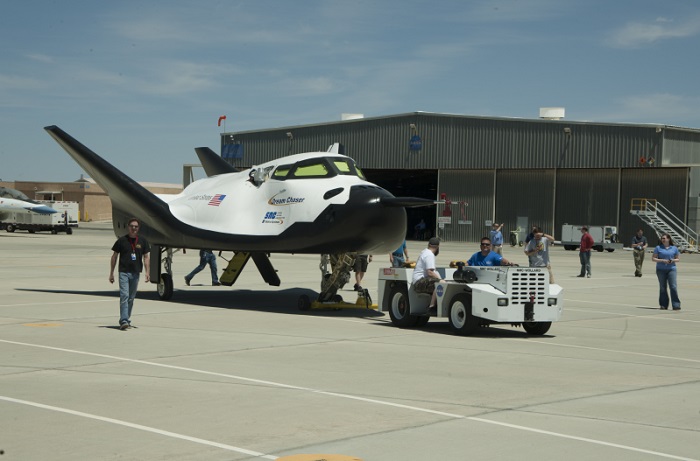
Sierra Nevada Corporation's Dream Chaser flight test vehicle is towed from its hangar at NASA's Dryden Flight Research Center in preparation for tow tests on a Dryden taxiway. The tow tests were part of ground tests in preparation for captive-carry and free-flight tests scheduled during the fall of 2013 at NASA Dryden. NASA / Ken Ulbrich May 30, 2013
.
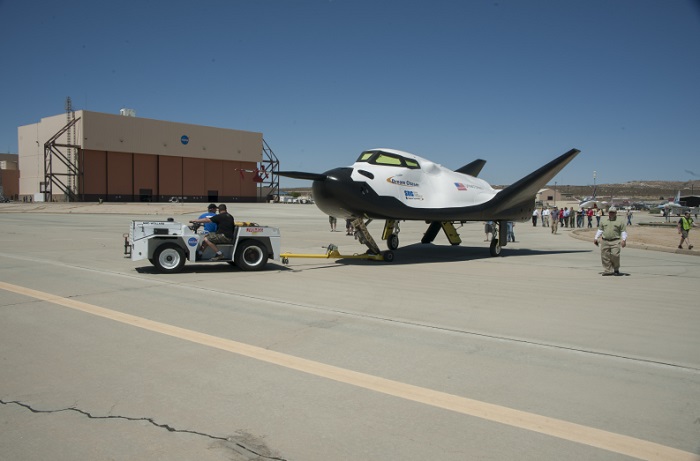
Sierra Nevada Corporation's Dream Chaser engineering test vehicle is towed across the ramp at NASA's Dryden Flight Research Center in preparation for tow tests on a Dryden taxiway. The tow tests were part of ground tests in preparation for captive-carry and free-flight tests scheduled during the fall of 2013 at NASA Dryden. NASA / Ken Ulbrich May 30, 2013
.
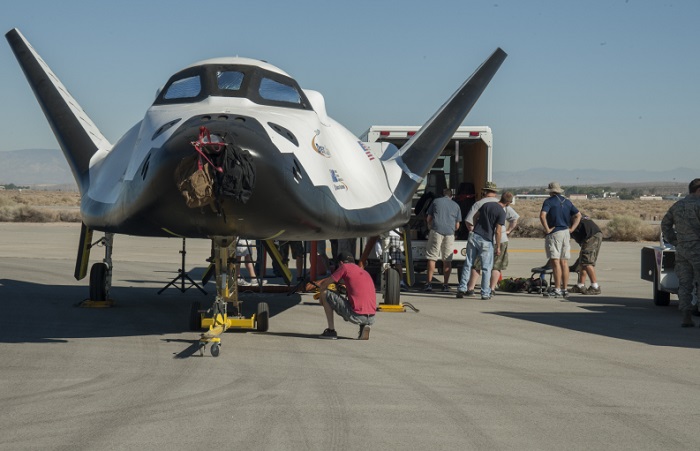
Sierra Nevada Corporation engineers and technicians prepare the firm's Dream Chaser engineering test vehicle for tow tests on a taxiway at NASA's Dryden Flight Research Center. The tow tests were part of ground tests in preparation for captive-carry and free-flight tests scheduled during the fall of 2013 at NASA Dryden. NASA / Ken Ulbrich June 27, 2013
.
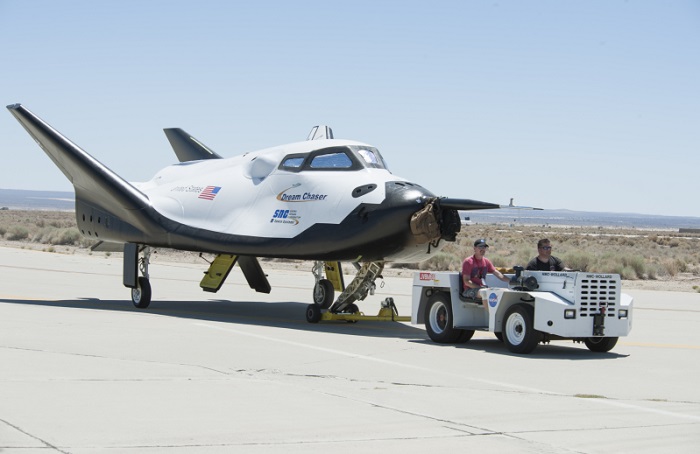
Sierra Nevada Corporation engineers and technicians prepare the firm's Dream Chaser engineering test vehicle for tow tests on a taxiway at NASA's Dryden Flight Research Center. The tow tests were part of ground tests in preparation for captive-carry and free-flight tests scheduled during the fall of 2013 at NASA Dryden. NASA / Ken Ulbrich June 27, 2013
.
Quelle: NASA
